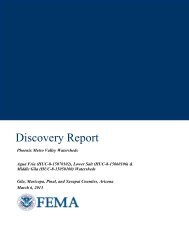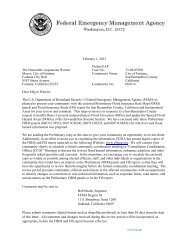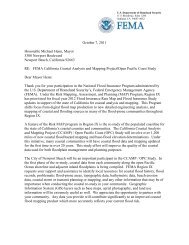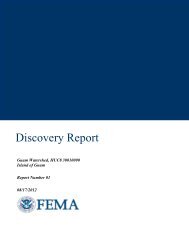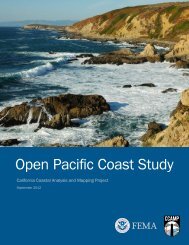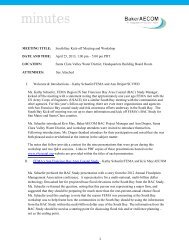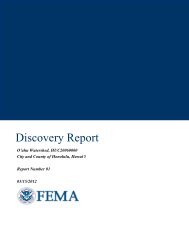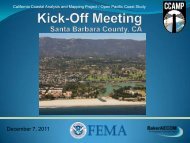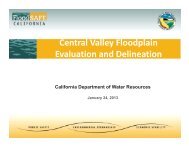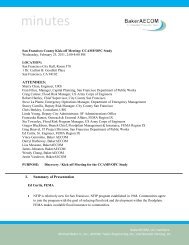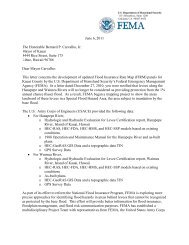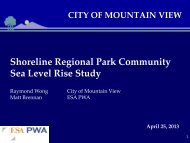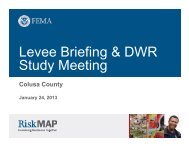YAVAPAI COUNTY, ARIZONA Federal Emergency ... - FEMA Region 9
YAVAPAI COUNTY, ARIZONA Federal Emergency ... - FEMA Region 9
YAVAPAI COUNTY, ARIZONA Federal Emergency ... - FEMA Region 9
Create successful ePaper yourself
Turn your PDF publications into a flip-book with our unique Google optimized e-Paper software.
ecommended as the approximate areas of 1-percent annual chance flooding in the<br />
event of failure of the levee.<br />
3.3 Vertical Datum<br />
All FISs and FIRMs are referenced to a specific vertical datum. The vertical<br />
datum provides a starting point against which flood, ground, and structure<br />
elevations can be referenced and compared. Until recently, the standard vertical<br />
datum in use for newly created or revised FISs and FIRMs was the National<br />
Geodetic Vertical Datum of 1929 (NGVD 29). With the finalization of the North<br />
American Vertical Datum of 1988 (NAVD 88), many FIS reports and FIRMs are<br />
being prepared using NAVD 88 as the referenced vertical datum.<br />
All flood elevations shown in this FIS report and on the FIRM are referenced to<br />
NAVD 88. Structure and ground elevations in the community must, therefore, be<br />
referenced to NAVD 88. It is important to note that adjacent communities may be<br />
referenced to NGVD29. This may result in differences in base flood elevations<br />
across the corporate limits between the communities.<br />
As noted above, the elevations shown in the FIS report and on the FIRM for<br />
Yavapai County are referenced to NAVD 88. Ground, structure, and flood<br />
elevations may be compared and/or referenced to NGVD 29 by applying a<br />
standard conversion factor.<br />
The conversion from NGVD 29 to NAVD 88 ranged between 2.0 and 3.15 for<br />
this community. Accordingly, due to the statistically significant range in<br />
conversion factors, an average conversion factor could not be established for the<br />
entire community. The elevations shown in the FIS report and on the FIRM were,<br />
therefore, converted to NAVD 88 using a stream-by-stream approach. In this<br />
method, an average conversion was established for each flooding source and<br />
applied accordingly. For Big Bug Creek, Granite Creek, and Hassayampa River<br />
elevations were converted to NAVD on a reach-by reach approach, applying<br />
different factors for the downstream and upstream reaches of the stream. The<br />
conversion factor(s) for each flooding source in the county may be found in the<br />
Table 8, “Vertical Datum Conversions,” shown below.<br />
The Base Flood Elevations shown on the FIRM represent whole-foot rounded<br />
values. For example, a Base Flood Elevation of 102.4 will appear as 102 on the<br />
FIRM and 102.6 will appear as 103. Therefore, users that wish to convert the<br />
elevations in this FIS to NGVD 29 should apply the stated conversion factor(s) to<br />
elevations shown on the Flood Profiles and supporting data tables in the FIS<br />
report, which are shown at a minimum to the nearest 0.1 foot.<br />
For more information on NAVD88, see Converting the National Flood Insurance<br />
Program to the North American Vertical Datum of 1988, <strong>FEMA</strong> Publication FIA-<br />
20/June 1992, or contact the Spatial Reference System Division, National<br />
Geodetic Survey, National Oceanic and Atmospheric Administration, 1315 East-<br />
West Highway, Silver Spring, Maryland 20910 (Internet address<br />
http://www.ngs.noaa.gov).<br />
50




